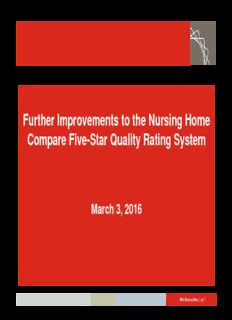
Further Improvements to the Nursing Home Compare Five-Star Quality Rating System PDF
Preview Further Improvements to the Nursing Home Compare Five-Star Quality Rating System
Further Improvements to the Nursing Home Compare Five-Star Quality Rating System March 3, 2016 Abt Associates | pg 1 Overview In April 2016, CMS will begin posting data for six new quality measures (QMs) on Nursing Home Compare: 1. Percentage of short-stay residents who were successfully discharged to the community (Claims-based) 2. Percentage of short-stay residents who have had an outpatient emergency department visit (Claims-based) 3. Percentage of short-stay residents who were re-hospitalized after a nursing home admission (Claims-based) 4. Percentage of short-stay residents who made improvements in function (MDS-based) 5. Percentage of long-stay residents whose ability to move independently worsened (MDS-based) 6. Percentage of long-stay residents who received an antianxiety or hypnotic medication (MDS-based) Abt Associates | pg 2 Overview Beginning in July 2016, five of the measures will be used in the calculation of Five-Star Quality Rating QM ratings. – Antianxiety/hypnotic medication measure will not be used in Five-Star due to concerns about its specificity and appropriate thresholds for star ratings. Addition of these new measures has several key benefits: – Increase the number of short-stay measures – Cover important domains not covered by other measures – Claims-based measures may be more accurate than MDS- based measures. Abt Associates | pg 3 Claims-Based Measures Overview of Claims-Based Measures Measures use Medicare claims, although the MDS is used in building stays and for some risk-adjustment variables. Measures only include Medicare fee-for-service beneficiaries. – Eventually, encounter data may allow us to include Medicare Advantage enrollees. All are short-stay measures that only include those who were admitted to the nursing home following an inpatient hospitalization. Measures are risk-adjusted, using items from claims, the enrollment database and the MDS Abt Associates | pg 5 Percentage of Short-Stay Residents Who Were Re-hospitalized After a Nursing Home Admission Development of readmission measures is a high priority for CMS: – The Protecting Access to Medicare Act calls for public reporting of readmission measures on Nursing Home Compare. – SNF Value-Based Purchasing (VBP) will use a claims-based readmission measure. Includes hospitalizations that occur after nursing home discharge but within 30-days of stay start date. – Includes observation stays. – Excludes planned readmissions and hospice patients. A ‘stay-based’ measure that includes both those who were previously in a nursing home and those who are new admits. Abt Associates | pg 6 Percentage of Short-Stay Residents Who Were Successfully Discharged to the Community For many short-stay patients, return to the community is the most important outcome associated with SNF care. Measure uses MDS assessments to identify community discharges and claims to determine whether the discharge was successful. – An episode-based measure that looks at whether resident is successfully discharged within 100 days of admission – Successful discharge defined as those for which the beneficiary was not hospitalized, was not readmitted to a nursing home, and did not die in the 30 days after discharge. Abt Associates | pg 7 Percentage of Short-Stay Residents Who Have Had an Outpatient Emergency Department Visit Better preventative care and access to physicians and nurse practitioners in an emergency may reduce rates of emergency department (ED) visits. Outpatient ED visit measure has same 30-day timeframe as the re-hospitalization measure and considers all outpatient ED visits except those that lead to an inpatient admission (which are captured by the re-hospitalization measure). Abt Associates | pg 8 Measure Specifications: Claims- Based Measures 100-day Community 30-Day All-Cause Discharge Without 30-Day Readmissions Readmission Outpatient ED Visits Data Source Part A claims to identify MDS to identify community Part B Claims to identify inpatient readmissions and discharges; claims to identify outpatient ED visits. Claims Part B claims for successful community and MDS for risk- observation stays. Claims discharges. Claims and MDS adjustment. and MDS are used for risk- for risk-adjustment. adjustment. Numerator 30 days after admission to a 100 days after admission to a 30 days after admission to a Window SNF following an inpatient SNF following an inpatient SNF following an inpatient hospitalization. hospitalization and 30 days hospitalization. following discharge. Denominator Patients must have been admitted to the nursing home following an inpatient Window hospitalization. Abt Associates | pg 9 Measure Specifications: Claims- Based Measures 100-day Community 30-Day All-Cause Discharge Without 30-Day Readmissions Readmission Outpatient ED Visits Measurement Rolling 12 months; updated every six months Period Numerator The number of SNF stays The number of SNF stays The number of SNF stays where there was a admitted where there was a discharge where there was an outpatient to an acute care hospital to the community (identified ER visit not resulting in an within 30 days of SNF using the discharge status inpatient stay or observation admission. Observation stays information on the MDS) stay within 30 days of SNF are included Planned within 100 days of admission admission. readmissions are excluded. who are not admitted to a hospital (inpatient or observation stay), a nursing home, or who die within 30 days of discharge. Numerator Planned readmissions None None Exclusions Abt Associates | pg 10
Description: